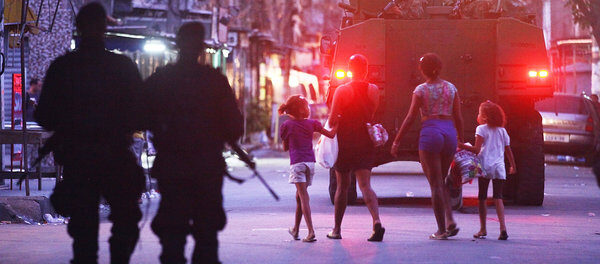
This is the latest contribution to our media watchdog series on the Best and Worst International Reporting on Rio’s favelas, part of RioOnWatch’s ongoing conversation on the media narrative and media portrayal surrounding favelas.
2014 was an unprecedented year for coverage of Rio’s favelas in the international media, with the World Cup and the upcoming 2016 Olympics shining an increasingly bright spotlight on the city’s challenges. RioOnWatch worked to support foreign journalists to report on favelas, providing information and contacts with the goal of facilitating nuanced representations of Rio and accurate reflections of community views. We also monitored the content and quality of English-language articles produced around the world over the course of the year. Many articles have highlighted critical and complex issues facing Rio today, providing diverse perspectives and telling previously little-known stories. We’ve noticed an exciting reduction of the use of words like ‘slum’ or ‘shantytown’ to describe favelas. This is a fantastic trend, as the deep-rooted stigma associated with ‘slum language’ in English obstructs efforts to approach favelas as communities with both challenges and potential solutions. However, 2014 still saw numerous articles that aimed to introduce foreign readers to favelas without offering resident perspectives, and as a result perpetuating old stigmas. In a context where rights and services have been historically denied based on prejudice, such reporting can have far-reaching negative consequences. Here we examine some of the poorer reporting on Rio’s favelas from 2014, and then highlight some of the pieces we thought best contributed to the ongoing discussion. Images used are those that accompanied the original articles.
THE WORST
Fox Sports – ‘Beautiful Chaos’ by Adam Peacock: Rio’s favelas were like visiting another world
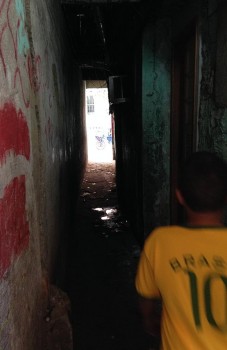 In December 2014, Fox Sports featured an account of a writer’s visit to Complexo do Alemão. The account lacks any direct perspectives from Brazilian favela residents. Instead, it is flush with quotes from an Irish-Australian NGO worker who was frequently sought out for information on the realities of favelas by English-speaking journalists during the World Cup. The absence of other perspectives leaves Peacock to make sweeping generalizations that stigmatize the population. “Parents are either desperately trying to make ends meet, or, more likely, trapped by drug addiction,” he writes, insinuating that most parents in the favela are addicts despite no evidence to support it. Meanwhile, imagery of happy but naïve kids with bare feet and “worn clothes held together by threads” portrays a level of poverty that does exist in Complexo do Alemão, but which is not pervasive. In fact, the community is increasingly home to lower-middle-class consumers and new businesses, including the area’s first shopping mall. For Peacock, however, the “stories and the sights” he encounters “depress the soul, which is further crushed upon realizing this is just one among thousands like it in Brazil.” Peacock joins the company of many journalists who reported on their own emotions as they toured favelas without reporting any community perspectives. A writer for the Irish Times describes the favela he visits as “an environment so tenuous and so hostile it is a wonder anyone can persevere with it,” but does not investigate how residents persevere, or whether they might have something positive to say about their environment. Unfortunately, this style of reporting, whereby the journalist’s own prejudices, expectations and limited impressions are projected into their representation of a place, wastes an opportunity to give a platform to the voices and ideas of favela residents, who already struggle to be heard in debates about their own lives.
In December 2014, Fox Sports featured an account of a writer’s visit to Complexo do Alemão. The account lacks any direct perspectives from Brazilian favela residents. Instead, it is flush with quotes from an Irish-Australian NGO worker who was frequently sought out for information on the realities of favelas by English-speaking journalists during the World Cup. The absence of other perspectives leaves Peacock to make sweeping generalizations that stigmatize the population. “Parents are either desperately trying to make ends meet, or, more likely, trapped by drug addiction,” he writes, insinuating that most parents in the favela are addicts despite no evidence to support it. Meanwhile, imagery of happy but naïve kids with bare feet and “worn clothes held together by threads” portrays a level of poverty that does exist in Complexo do Alemão, but which is not pervasive. In fact, the community is increasingly home to lower-middle-class consumers and new businesses, including the area’s first shopping mall. For Peacock, however, the “stories and the sights” he encounters “depress the soul, which is further crushed upon realizing this is just one among thousands like it in Brazil.” Peacock joins the company of many journalists who reported on their own emotions as they toured favelas without reporting any community perspectives. A writer for the Irish Times describes the favela he visits as “an environment so tenuous and so hostile it is a wonder anyone can persevere with it,” but does not investigate how residents persevere, or whether they might have something positive to say about their environment. Unfortunately, this style of reporting, whereby the journalist’s own prejudices, expectations and limited impressions are projected into their representation of a place, wastes an opportunity to give a platform to the voices and ideas of favela residents, who already struggle to be heard in debates about their own lives.
The Daily Beast – Rio’s real-life slumdog millionaires
This unfortunately-titled article from The Daily Beast reports that improved security brought about by the government’s Pacifying Police Unit (UPP) program has transformed the residents of Vidigal’s ocean-view properties into a “new legion of unintentional real estate tycoons.” The author wonders whether residents should “sell now and cash in their millions, or hold tight for a chance to make even more.” Without providing a single quote from a resident of Vidigal, the author assumes residents must be looking to play this “ultimate game of real-estate roulette” and sell their way out of the community he portrays as an undesirable living environment. However, as examples from favelas across the city have demonstrated, many people choose to turn down significant amounts of money in order to remain in their communities. 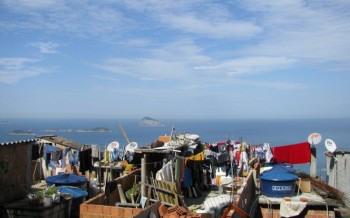 Failing to recognize the assets of favelas, as this article does, leads to policies that seek to remove neighborhoods entirely rather than work with inhabitants to improve them. Furthermore, the author fails to explore the implications of real estate speculation on rental tenants in the community, nor the reality that, rather than a real estate gold mine, Rio’s favelas are the city’s affordable housing stock and designated ‘zones of special social interest.’ The author does not provide a single example of a resident who has successfully sold a home for millions. By glorifying the new market opportunities available to residents, this piece minimizes the very real threats of gentrification and Vidigal’s efforts to debate and formulate community-led responses to this phenomenon.
Failing to recognize the assets of favelas, as this article does, leads to policies that seek to remove neighborhoods entirely rather than work with inhabitants to improve them. Furthermore, the author fails to explore the implications of real estate speculation on rental tenants in the community, nor the reality that, rather than a real estate gold mine, Rio’s favelas are the city’s affordable housing stock and designated ‘zones of special social interest.’ The author does not provide a single example of a resident who has successfully sold a home for millions. By glorifying the new market opportunities available to residents, this piece minimizes the very real threats of gentrification and Vidigal’s efforts to debate and formulate community-led responses to this phenomenon.
Gulf Times – A doctor’s house call in a favela
At the beginning of the World Cup various outlets published the reflections of a US-based doctor who visited Rocinha, including Gulf Times, Counterpunch, Japan Times, and others, leading to the circulation of this piece among different audiences throughout the duration of the tournament. The doctor presents information that is both false–such as his statement that police are “normally unable to enter favelas”–and stigmatizing–for example the assertion that “favelas house many people involved in drug trade and other crimes.” Did the doctor think it would make for a less compelling piece to admit that 99% of favela residents are not directly involved with drug trafficking? His story about having to check in with men at each “level” of the favela in order to “reach the upper level alive” simply does not reflect the experience of visitors to Rocinha. It is unfortunate that this sensationalist story was given multiple platforms from which to influence readers around the world.
THE BEST
Next City — Ghettos of the World Cup
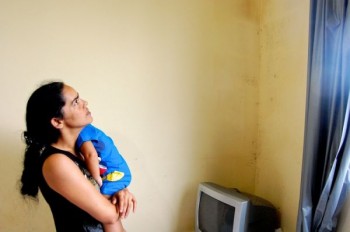 Published at the beginning of the World Cup, this comprehensive research piece draws together interviews, extensive geospatial and housing data, and pertinent historical context to provide an in-depth exploration of the current state of displacement and housing projects in Rio. Forefronted in the article is the testimony of a family who were moved into a housing project from their home in the favela Vila Recreio II. The result is a strong critique of Brazil’s Minha Casa Minha Vida housing project policy and an important collection of evidence with which to challenge those in the government and mainstream Brazilian media who have only praises for the policy. The same author wrote another of our favorite 2014 pieces, titled ‘This neighborhood needed a basic sanitation system–it got a gondola instead.’ This article is a great example of how to report on the significant challenges facing favelas without falling into common traps of stigmatizing the residents or emphasizing outsider perspectives. The author first states a number of facts: “Alemão is the neighborhood with the lowest Human Development Index in the city of Rio. Here, people live on average seven years fewer than residents of the rest of the city. Tuberculosis is a problem, and many residents miss school and work due to illness.” Then, the author emphasizes the ways in which community leaders are taking action–online petitions, packed public forums, op-eds, and innovative educational initiatives–and forefronts quotes from residents who propose solutions.
Published at the beginning of the World Cup, this comprehensive research piece draws together interviews, extensive geospatial and housing data, and pertinent historical context to provide an in-depth exploration of the current state of displacement and housing projects in Rio. Forefronted in the article is the testimony of a family who were moved into a housing project from their home in the favela Vila Recreio II. The result is a strong critique of Brazil’s Minha Casa Minha Vida housing project policy and an important collection of evidence with which to challenge those in the government and mainstream Brazilian media who have only praises for the policy. The same author wrote another of our favorite 2014 pieces, titled ‘This neighborhood needed a basic sanitation system–it got a gondola instead.’ This article is a great example of how to report on the significant challenges facing favelas without falling into common traps of stigmatizing the residents or emphasizing outsider perspectives. The author first states a number of facts: “Alemão is the neighborhood with the lowest Human Development Index in the city of Rio. Here, people live on average seven years fewer than residents of the rest of the city. Tuberculosis is a problem, and many residents miss school and work due to illness.” Then, the author emphasizes the ways in which community leaders are taking action–online petitions, packed public forums, op-eds, and innovative educational initiatives–and forefronts quotes from residents who propose solutions.
NPR – In Brazil, Race is a matter of life and death
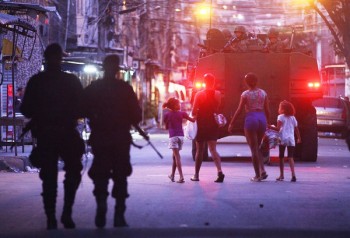 Reporting on violence and dissecting race issues is always a challenging task for journalists, and this article serves as an excellent example of diligent research and productive conversation. The author draws attention to an incidence of police violence that occurred the day before the World Cup began but which was largely ignored by international media. She contextualizes the event with key national statistics, quotes from a diverse range of sources, and a description of her visit to Maré, where the police’s victim lived. She uses her visit to describe the experience of entering the favela as a visitor and to recount a conversation with a resident–the victim’s father. The author states her observations–“Every few corners, a group looks us over…Trucks loaded with helmeted and heavily armed troops travel through the streets. It has the feel of a war, not a policing operation” which contrast sharply with reporting implying that police operations have civilian aims–while avoiding the pitfalls of speculation based on pre-existing expectations. The different aspects of her research combine effectively to make an important argument: that security in Brazil must be considered in the context of racial inequalities. This is the first piece to announce a critical statistic in understanding the trends in Brazil today: “Brazil actually has gotten a lot safer for white people. In the past decade, homicides among whites have decreased 24 percent. But among the black population they have increased 40 percent.”
Reporting on violence and dissecting race issues is always a challenging task for journalists, and this article serves as an excellent example of diligent research and productive conversation. The author draws attention to an incidence of police violence that occurred the day before the World Cup began but which was largely ignored by international media. She contextualizes the event with key national statistics, quotes from a diverse range of sources, and a description of her visit to Maré, where the police’s victim lived. She uses her visit to describe the experience of entering the favela as a visitor and to recount a conversation with a resident–the victim’s father. The author states her observations–“Every few corners, a group looks us over…Trucks loaded with helmeted and heavily armed troops travel through the streets. It has the feel of a war, not a policing operation” which contrast sharply with reporting implying that police operations have civilian aims–while avoiding the pitfalls of speculation based on pre-existing expectations. The different aspects of her research combine effectively to make an important argument: that security in Brazil must be considered in the context of racial inequalities. This is the first piece to announce a critical statistic in understanding the trends in Brazil today: “Brazil actually has gotten a lot safer for white people. In the past decade, homicides among whites have decreased 24 percent. But among the black population they have increased 40 percent.”
More great reporting
Other great contributions about favelas and Rio from 2014 included architect Solène Veysseyre’s informal study of “The Unspoken Rules of Favela Construction,” Simon Jenkins’ argument for a downsized Rio Olympics to minimize the negative impacts on favelas and the rest of the city, and Vac Verikatis’ analysis of World Cup impacts in The Daily Beast. There is also an emerging field of articles that approach favelas as assets, including pieces from The Age, The Independent, Gizmodo, and Generation C Magazine. Articles like this one from GlobalVoices provided space for photographs taken by favela youth in order to represent the community through their lenses. There were also a number of writers and outlets that, throughout the year, consistently covered issues in Rio with sensitivity and productive representations: Julia Michaels on RioReal, Dave Zirin at The Nation, Rachel Glickhouse on RioGringa, Chris Gaffney on Hunting White Elephants, Favelissues, and the Favelas@LSE blog.
